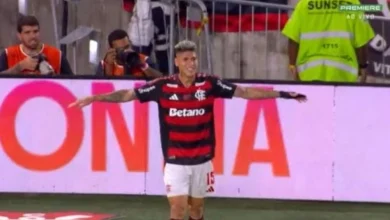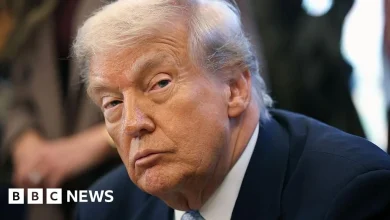Ryder Cupper teases intriguing PGA Tour changes: ‘We’ll see’

What will the ‘new’ PGA Tour look like?
It’s a question golf fans have been asking for several years now, three or four or more, since the arrival of LIV threw the entire pro-golf ecosystem into chaos. We got one answer when the Tour rolled out its new limited-field, big-money Signature Event model for the 2023 season; that model has evolved each year since. But the arrival of new CEO Brian Rolapp this summer put everybody on notice that bigger, more substantial change is coming. He appointed Tiger Woods to chair the Future Competitions Committee and didn’t mince words in describing what’s to come:
“The goal is not incremental change,” Rolapp said in August. “The goal is significant change.”
So what’ll that look like? We’ll see. And we’ll look for clues. And we got one on Wednesday, when Harris English — the top-ranked player at this week’s RSM Classic, the final event of the 2025 Tour season — teased out one version of what “significant change” might mean.
“We’ve got some smart guys at the helm. Now with Brian Rolapp coming in, he’s seeing the PGA Tour in a different light,” said English. This is a near-unanimous sentiment about Rolapp, who everybody on the PGA Tour describes as “impressive.” (Perhaps it’s because they all love football, and because Rolapp’s former employer, the NFL, is such a behemoth. That’s the subtext: if Rolapp’s leadership was good enough for them, it’s good enough for the Tour.)
But here’s where things got interesting:
“Sometimes change is good,” English said. “I get that they want all the best players playing together more often, and the talk of the Tour potentially starting after the Super Bowl I think is a pretty good thing because we can’t really compete with football. So we’ll see where it goes.”
Starting after the Super Bowl! That would be news indeed. Sources familiar with Tour discussions have suggested that nothing is set in stone, but it’s clear the season’s structure is on the table. English’s proposed schedule does include a red flag — the WM Phoenix Open traditionally runs the same week as the Big Game and is the most attended event on Tour; surely they wouldn’t move that? But his larger point stands. The Tour has been doing its best to dodge the NFL schedule to avoid competing for Sundays. It seems logical that the NFL’s offseason would be the Tour’s in-season.
So what would that season look like? English suggested that the Signature-Event model may get another massive modification — or face elimination altogether.
“I think that’s what they’re going to change down the road, maybe in 2027, is have all the tournaments be equal and not have the eight elevated events and the regular events. They’ll have 20, 22 events that are all the same,” he said. “I think that’s a good model to have. That’s where you’ll see all the top players play every single event because you can’t really afford to take one off.”
English’s suggestion would solve what is arguably the Tour’s biggest branding problem: currently it’s tough to define the difference between a Signature Event and a normal full-field event when they’re both considered PGA Tour events. If there were fewer events it’d be easier to delineate importance.
English wanted to make one thing clear, though: he feels grateful to play any and all of them.
“As it goes for the elevated events, like, I love — even if they weren’t elevated I’d probably play all of them. I have for a long time,” he said. “Really, Pebble’s the only one that I didn’t play for a good amount of time in my career just where it fell in the schedule. I love playing on the West Coast. I love getting off to that start, playing a lot of events over there and get your season started off good. We’ll see where it goes. I think they’ll more go where 20 events are all the same, all the points, all the money, everything the same.”
The Tour’s tea leaves have been difficult to read with perfect clarity. Even as Rolapp talks of scarcity, his Tour has added two new fall events for the coming years with new venues and new sponsors. There are open questions about Hawaii’s future as part of the schedule; English expressed his regret that the Tour won’t be going to Kapalua this year, where they typically start the calendar season, and he’d be bummed to see the Hawaiian swing go away or to lose other venues that follow like Torrey Pines or even the fall events. Cutting tournaments can sound on paper like the logical move. That doesn’t mean it comes without consequences.
“Tournaments like this, I don’t want to see them go away because I know how much they mean to this community. A lot of these fall events, we go to a lot of places in the country that they don’t get a whole lot of golf tournaments and you can tap into a different fan base. I don’t really want to see them go away, but I think they’ll find a time and a place for some of those,” he said.
English, 36, is used to the Tour’s tinkering. While some things have stayed the same — this is his 14th time playing the RSM — plenty of others haven’t. He’s seen points, payouts, schedules, structures and rewards change and change and change again. His message here again was clear: Wherever they tell me I can play, I’m going to play. And change can be for the best.
“When you look at other leagues, they’re all super competitive and what you did two or three years ago doesn’t mean anything today,” he said. “The NFL cuts guys all the time. We’re getting pretty cutthroat out here, but if it makes our product better and more fans watch and more fans are coming out here to tournaments, then I’m all for it.”
“>





